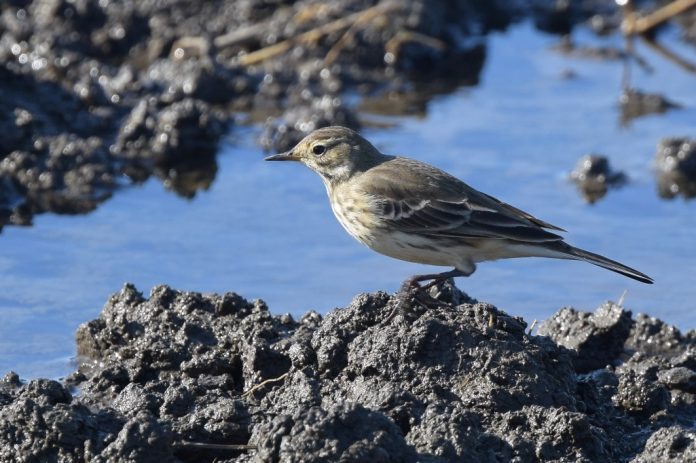IDENTIFICATION – American pipit size is about 15.5-17 cm in length. It is known as American Pipit in North America and called Buff-bellied Pipit (Anthus rubescens) in Eurasia. It is a medium-sized songbird, previously classified as a form of Water pipit. There are two races that have occurred in Europe, as vagrants (from breeding areas in Eastern Siberia and North America), and their identification involves different criteria.
Both are marginally smaller and slimmer than Rock or Water Pipit, with a shorter, finer, more Meadow Pipit-like bill. The Siberian race more often than not also has distinctly pale legs (only rarely seen in North American race or water). North American race: The winter birds in fresh plumage in autumn have entire underparts warm buff, quite unlike any other pipit of our region, becoming whiter on throat and breast center, and with supercilium and wing bars buff, lacking yellowish tones.
The underpart streaking is clear and narrow, extending widely across the breast and less conspicuously and more finely along the flanks (dark streaks are larger but less clean-cut in water).
The entire upperparts are dull olive-brown, virtually unstreaked, although the mantle and crown have weak dark feather centers; as in Water Pipit, the legs are very dark brown, and the outer tail feathers are clean white. With wear, the buff of the underparts becomes paler and the brown of the upperparts duller, less olive.
Therefore, the confusion is possibly most likely with buff-toned individuals of Meadow pipit, but Buff-bellied lacks obvious streaking on upperparts and has dark legs and a distinct supercilium; spring littoralis Rock pipit can be vaguely similar below, but has broader flank streaking, is stockier, has a dull white outer tail, and is washed dull yellow rather than buff on the ventral region.
In summer plumage, the head and upperparts grayish, unstreaked, with buff supercilium, underpart streaking reduced to breast sides and flanks, and breast strongly flushed pinkish; resembles water, but underparts wholly buffish, not whitish, although similarly pink-flushed on breast, with dark streaking on breast sides and flanks more distinct and supercilium buffish, rather than whitish.

In all plumage lacks a dark loral line (breaking pale eye-ring) of Water and Rock, but beware of effects of shadow, and moustachial stripes are usually more distinct. Siberian race: In fresh winter plumage in autumn, upper parts are very dark dusky olive-brown, with streaking very faint, merely dark feather centers to mantle and crown.
The supercilium is whitish and there is a prominent whitish eye-ring; the underparts are very heavily and broadly streaked with blackish spots and stripes, extending along the full length of the flanks on a pale buff background, becoming whiter on the throat, breast, and under tail coverts.
The streaking is heavier and more distinct than in the American race or water. In summer plumage the underpart streaking is slightly reduced, but is more extensive and distinct than in American race or water, especially along the flanks, and the breast is washed cinnamon-pink (thus warmer toned than American race or water); the upperparts are darker, less gray, than in American race.
As in water, the outer tail feathers are white, but the legs are pale yellowish- or reddish-brown, much lighter than in most water, but darker than in Meadow. The almost unstreaked upperparts prevent confusion with Meadow or Red-throated at all times, although the call and paler legs suggest Meadow rather than water. In all plumage lacks a dark loral line (breaking pale eye-ring) of Water and Rock, but beware of effects of shadow, and moustachial stripes are usually more distinct.

SEX/AGE – Spring males often have a more extensive pinkish flush on the breast and more reduced breast streaking than females. Seasonal variation is discussed under Identification. Juveniles are unlikely to be found in our region, but 1st-autumn birds are brighter and buffer below adults, with fresher and brighter wing feathers forming a stronger wing pattern.
VOICE – American pipit call resembles those of Water, Rock, and Meadow Pipits. With experienced ear, typical flight calls slightly thinner, less shrill than that of Water, more like that of Meadow, although more squeaked, higher in pitch and slightly longer: a short ‘tsiip’ or ‘seet’, repeated at more widely-spaced intervals than in Meadow. The song, unlikely to be heard in our region, recalls Rock.
TAXONOMY – Formerly treated as nonspecific with Water Pipit under (Anthus spinoletta).
GEOGRAPHICAL VARIATION – There are moderate two races (both illustrated). Differences between the vagrant nominate race (breeds North America and NE Siberia) and vagrant japonicus (breeds E Siberia) are discussed under Identification.
HABITAT – Nominate race a vagrant to W Europe. E Siberian race japonicus perhaps a regular winter visitor to Southern Israel is tiny numbers. Hence, presumably occurs elsewhere in the Middle East; vagrant to Southern Europe. Habitat is very much like those of Water pipit at a similar season. In Israel, wintering birds occur in well-watered grassy fields, with small puddles and muddy edges.







